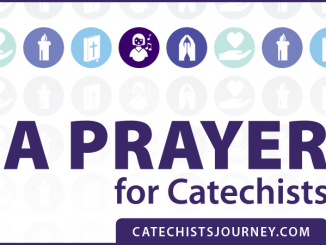
How do you plan your lessons for faith formation sessions? The majority of us catechists don’t hold education degrees, so we likely don’t have much, if any, formal training in lesson planning. A good catechetical textbook with a teacher’s manual may outline ways to approach each lesson. This can be a great starting point, especially for new catechists. But with some experience, we can approach lesson planning in ways personalized to the group we have in front of us each year.
I begin any lesson planning with a quick prayer asking the Holy Spirit to guide me. I then read the chapter of the week in the children’s book. This gets my mind working on possible ways to present and interact with the material. In fact, I try to read the chapter a few days before sitting down to write a lesson plan. This helps me become familiar with the theme and consider options as to what techniques I might employ on a given week. That choice will depend partly on what techniques I used during the last session. For instance, if I did an art project last time, I might lean toward a game or written activity next time. I like to diversify prayer experiences too, so that a guided reflection one week is followed by a prayer service, lectio divina, or a traditional prayer like the Apostles’ Creed or the Act of Faith in the following sessions.
After a couple of days mulling over the plan in the back of my mind as I work on other things, I will read the catechist guide. I see what techniques the book suggests and determine which ideas I’ll incorporate or replace with ones I’ve thought of myself or found from other sources. Since I’ve been a catechist for more than 15 years, I have a storehouse of activities collected from the Web, conferences, and books. I know what has or hasn’t worked in the past, so I rely on my experience to determine the exact activities to include for a particular topic. (Of course, just because some activities may not have worked with one group in the past is never a reason of itself to dismiss an activity forever.) I also consider the preferences of the particular group I have that year; for example, this year’s group prefers art projects to small-group discussion. I try to expand my repertoire so that I’m not leading activities just because they are ones I’m familiar with. I always want to be open to trying new ideas that my group would respond to better. The most important consideration is that the planned activities work together to support the theme of the week for the young people.
Once I have an idea of what activities I want to include in the lesson, I’m ready to set down a plan on paper. I don’t usually bother writing a formal list of materials on my plan sheet, but I know that’s helpful for other catechists. I gather anything I need from home at the time I plan so that I don’t forget things on class night. I also make sure that my lesson plan includes more than I can achieve in the time allotted. (It is always better to be over-prepared than running out of things to do.) Armed with my plan, I can confidently walk into sessions ready to go, knowing that the Holy Spirit is there to guide me.
What is your approach to lesson planning? If you are a more experienced catechist, how has your approach changed with time? If you are a newer catechist, what questions do you have about lesson planning?



Great framework and factors to consider, Denise – for both experienced and new Catechists! This is probably part of your thought process when you think about tailoring a lesson to your class/group each year, but I thought I’d mention it – think about where your students “are on their faith journey” relative to the faith concept, doctrine or Bible story to be covered in each lesson.
Our DRE suggested we build this into each of our lesson plans in our Salvation History curriculum, and I have found it extremely helpful in “meeting them where they are” and guiding the youth to new understanding, a new encounter with Christ, and new ways to apply what they learn to their lives. Thanks again for sharing your experiences!
Mary, meeting the young people where they are is so important. St. Ignatius Loyola encouraged us to go through their door so as to come out our door, so this is clearly advice that withstands the test of time! It makes no sense to start lessons from a place the children can’t understand, so your DRE gave you good advice for your own planning. Thank you for sharing your thoughts.
Denise, I love your reference to St. Ignatius Loyola “going through their door so as to come out our door.” Another important part of lesson planning that I have learned over the years – identifying open-ended questions to insert throughout the lesson – to check for understanding, to integrate a couple of main ideas, or to help the youth extend their learning with a real-life application.
The Catechist/teacher manual will have such questions, and I like to create some additional ones in the lesson. I find it helpful to have a back-up question in mind if the initial response to a question is the “deer in the headlights” look. It is tempting to just “tell” the class the correct answer, but a series of open-ended questions really helps them “discover” God’s message/revelation. As you mentioned, they “come through the door”. Thanks!